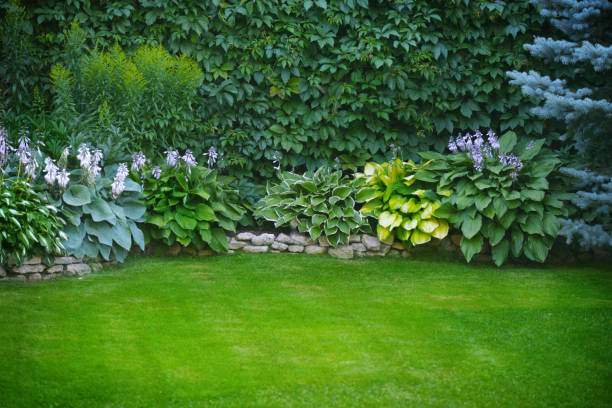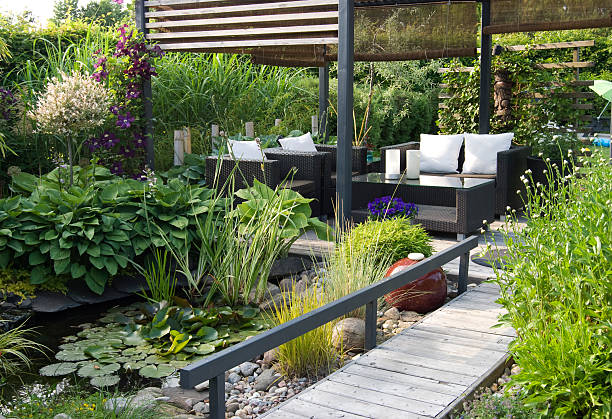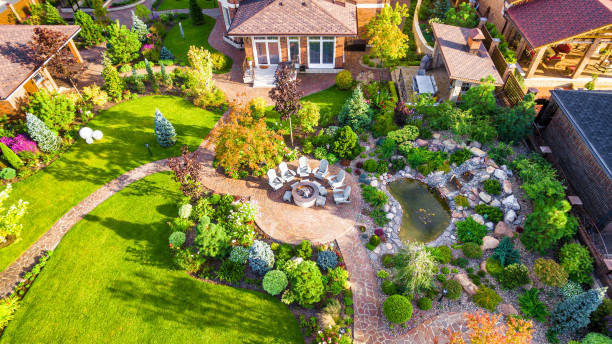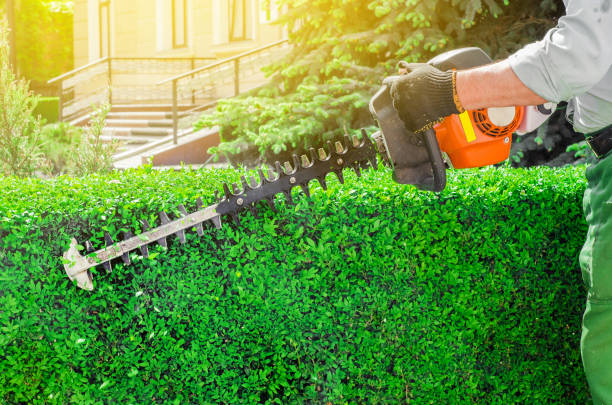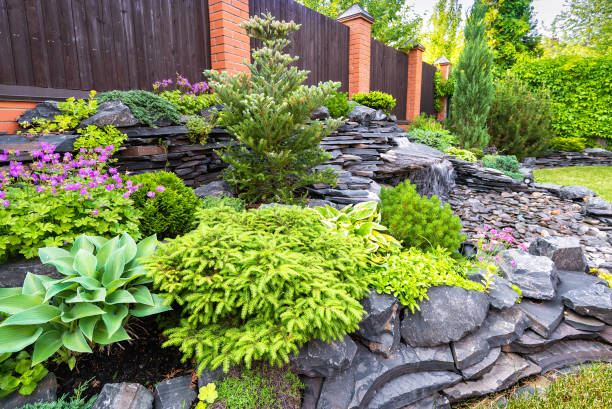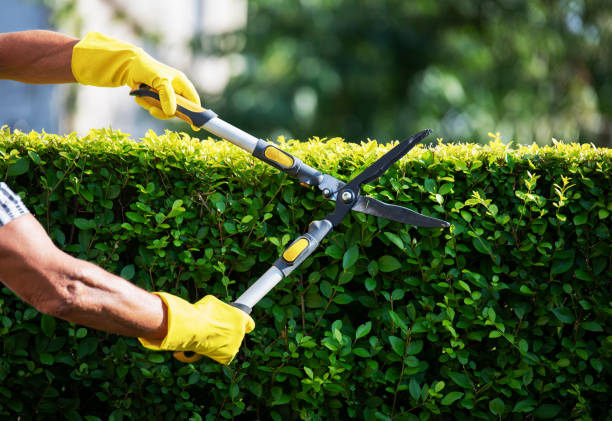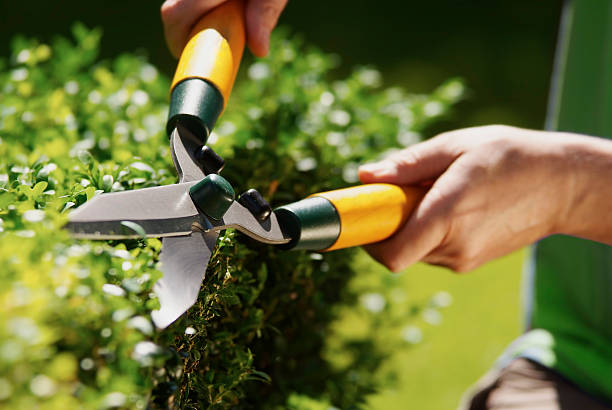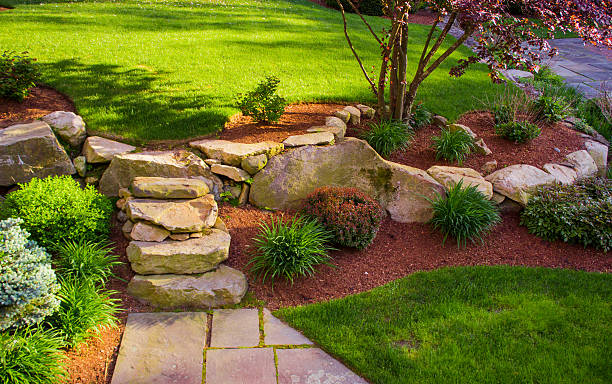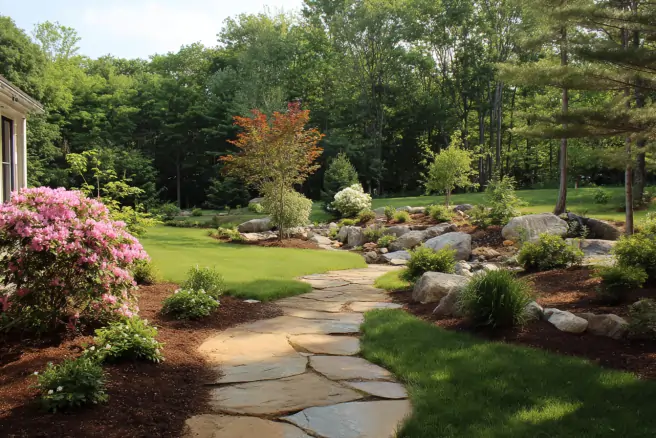
Creating a stunning landscape design requires careful planning, creativity, and an understanding of your outdoor space. Whether you’re starting from scratch or updating an existing garden, following these practical tips will help you achieve a visually appealing and functional outdoor environment.
Assess Your Space
- Size and Layout: Measure the dimensions of your yard to identify limitations or opportunities.
- Sunlight Exposure: Observe how sunlight moves through your space at different times of day.
- Soil Quality: Test the soil to determine its pH level and nutrient content. This will influence plant choices.
- Climate: Factor in local weather conditions when selecting plants, materials, and water features.
Take note of any existing structures like patios, walkways, or fences that can be incorporated into the design.
Define Your Goals
- Do I want a low-maintenance garden?
- Should the space include areas for entertaining?
- Will children or pets use the yard frequently?
- Am I looking for privacy or open views?
By defining clear goals for your project, you can make more informed decisions about plant selection and layout.
Plan Functional Zones
| Zone Type | Common Features |
| Relaxation Zone | Comfortable seating, shade trees |
| Entertainment Area | Outdoor furniture, grill station, lighting |
| Play Area | Open lawn space or play equipment |
| Garden Beds | Flower beds, vegetable patches |
Mapping out these zones will help create a balanced flow throughout your landscape.
Choose Plants Wisely
- Focus on Native Plants: Native species are adapted to local climates and are easier to maintain.
- Layer Plant Heights: Use tall trees in the background, medium shrubs in the middle layer, and shorter flowers in front.
- Consider Year-Round Interest: Mix evergreens with deciduous plants to maintain visual appeal across seasons.
- Group by Water Needs: Position plants with similar water requirements together for efficient irrigation.
For example: – Low Maintenance Options: Lavender, succulents – Seasonal Color Variety: Tulips (spring), hydrangeas (summer), asters (fall)
Incorporate Hardscaping Elements
- Walkways made of natural stone or brick
- Retaining walls to prevent soil erosion
- Pergolas or trellises for shaded areas
- Patios constructed from concrete pavers
These elements not only add visual appeal but also increase property value.
Lighting Matters
- Pathway lights along walkways
- Spotlights focused on trees or sculptures
- String lights around patios for ambiance
Energy-efficient LED lights are both eco-friendly and cost-effective over time.
Creating a stunning landscape requires thoughtful planning but yields rewards in terms of beauty and functionality. By assessing your space carefully, setting goals, zoning effectively, choosing plants wisely, incorporating hardscaping elements strategically—and not forgetting lighting—you can create an outdoor area tailored perfectly to your needs.
Essential Tips and Advice for Milton, MA Landscaping Design
Creating a stunning landscape design involves a combination of creativity, planning, and an understanding of key principles. Whether you’re working on your backyard, front yard, or any outdoor space, the following tips will guide you through the process to craft an eye-catching and functional design.
Learn About Lawn Care Milton, MA Services
Before diving into landscaping ideas, it’s crucial to analyze your site. Consider these factors:
– Climate and Weather: Know your region’s climate to choose plants that thrive locally.
– Soil Type: Test your soil’s pH level and texture to determine suitable plants.
– Light Conditions: Observe how sunlight moves across the space throughout the day.
By understanding these elements, you can make informed decisions about plant choices, layout, and materials.
Expert Lawn Maintenance in Milton MA
GreenOp: Commercial & Residential Landscape Management Boston: Landscaping Services
https://greenoplandscape.com
A well-planned design ensures that every element serves a purpose while enhancing aesthetics. Begin with the following steps:
1. Set Clear Goals: Decide if your primary focus is entertainment, relaxation, or increasing curb appeal.
2. Create Zones: Divide your outdoor area into functional zones such as seating areas, pathways, gardens, or recreational spaces. 3. Think Long-Term: Account for plant growth over time and maintenance needs.
Using graph paper or digital tools can help sketch out initial designs.
Choose Suitable Plants
Selecting the right plants is pivotal to achieving a vibrant landscape:
– Opt for native plants as they require less water and maintenance once established. – Incorporate a mix of perennials (long-lasting) and annuals (seasonal pops of color).
– Group plants with similar water and sunlight needs together for efficiency.
| Condition | Examples of Plants |
| Full Sun | Lavender, Marigold, Sedum |
| Partial Shade | Hostas, Ferns, Bleeding Hearts |
| Dry Soil | Yarrow, Russian Sage |
| Wet Soil | Irises, Cattails |
Focus on Hardscape Elements
Hardscaping refers to non-living features in your space like patios, walkways, walls, or water elements:
– Use materials like stone or pavers for durability and timeless appeal.
– Define pathways with gravel or stepping stones for structure while maintaining an organic feel. – Introduce focal points such as fountains or sculptures to elevate visual interest.
Blending hardscape elements with greenery leads to a balanced look.
Master Color and Texture Combinations
An appealing landscape design incorporates harmonious color schemes and textures:
1. Use complementary colors (e.g., blue flowers paired with orange blooms) for vibrancy. 2. Add variety in leaf shapes—combine broad leaves with feathery foliage for contrast. 3. Layer heights by placing taller plants at the back and shorter ones in front to create depth.
Maintain Regularly
Even the most beautiful landscapes require consistent care:
– Prune shrubs regularly to maintain their shape. – Mulch garden beds annually to retain moisture and suppress weeds. – Inspect lawns and remove weeds promptly before they spread.
Routine maintenance ensures your landscape remains inviting throughout all seasons.
By combining thoughtful planning with execution rooted in practicality and creativity, you can create an outdoor space that is both stunning and functional over time!
The Three Major Principles of Landscape Design You Need to Know
When it comes to creating a functional and visually appealing outdoor space, understanding the core principles of landscape design is essential. These foundational principles—unity, balance, and proportion—serve as a guide for designing harmonious and cohesive landscapes that enhance the aesthetic value of your space while meeting practical needs. Below is an in-depth look at these three major principles and how you can apply them effectively.
Unity: Creating a Cohesive Look
Unity is about ensuring all elements within your outdoor space work together to form a consistent theme or style. It’s important to tie together various components like plants, hardscapes, furniture, and decorative features so they feel interconnected rather than disjointed.
Ways to Achieve Unity: – Use Repetition: Repeating patterns or features such as colors, textures, or specific plant species throughout the landscape creates a sense of continuity. – Maintain Consistency: Stick with a defined design style (e.g., modern, rustic, minimalist) across all areas of your yard. – Create Focal Points: Incorporate eye-catching elements like water features or sculptures that draw attention but don’t overwhelm the overall design.
| Element | Tips for Consistency | Examples |
| Plants | Use similar species and colors | Group lavender or boxwood |
| Hardscape Materials | Match textures and finishes | Choose stone paths in gray tones |
| Furniture & Decor | Keep materials uniform | Use wood or metal consistently |
Balance: Ensuring Visual Stability
- Both sides of the garden are mirror images.
- Commonly used in formal gardens (e.g., traditional European designs).
- Ideal for creating an elegant atmosphere.
- Elements are intentionally varied while maintaining visual stability.
- Better suited for naturalistic or informal garden styles.
- Example: Pairing a large tree on one side with several smaller shrubs on the other.
To achieve balance: – Assess scale and size when placing plants and features. – Distribute visual weight evenly by combining contrasting yet complementary forms (e.g., tall trees next to low-growing plants).
Proportion: Keeping Everything in Scale
Proportion ensures that each element within your design fits well with others as well as the overall space. Misjudged proportions can make a small garden feel cramped or cause larger spaces to appear sparse and unfinished.
Key Tips for Applying Proportion: – Consider Plant Sizes: Select plants that will fit their surroundings both when planted and at maturity. – Example: Avoid placing towering trees too close to smaller bushes as it may overshadow them. – Scale Structures Appropriately: Patios, pathways, pergolas, and furniture should match the size of your yard rather than overwhelm it. – In small yards: Opt for compact patios with narrow paths. – In larger yards: Use wider walkways with expansive seating areas. – Layer Elements Gradually: Arrange taller elements towards the back (e.g., tall hedges) and shorter ones (like flowers) towards the front.
By incorporating unity, balance, and proportion into your landscape design process, you’ll build an outdoor space that not only looks cohesive but also provides functionality tailored to its environment. These principles are adaptable across various garden styles — from minimalist urban courtyards to sprawling suburban backyards — making them timeless tools in any designer’s toolkit.
Key Differences Between a Landscape Designer and a Landscape Architect Explained
When embarking on a landscaping project, understanding the distinctions between a landscape designer and a landscape architect is pivotal. While both professionals work to enhance outdoor spaces, their expertise, training, and scope of work differ significantly. Here’s a detailed breakdown to help you determine which professional is best suited for your project.
Education and Credentials
- Typically does not require formal certification or licensing.
- May have training in horticulture, garden design, or similar fields.
- Focuses on residential projects or small-scale designs.
- Requires formal education—usually a bachelor’s or master’s degree in landscape architecture.
- Must obtain licensure by passing the Landscape Architect Registration Examination (LARE).
- Well-versed in technical aspects such as engineering, drainage systems, and environmental sustainability.
| Criteria | Landscape Designer | Landscape Architect |
| Education | Informal or specialized courses | Degree in landscape architecture |
| Licensing Required? | No | Yes |
| Scope of Knowledge | Plants, aesthetics, garden layouts | Infrastructure, regulations, large-scale projects |
Project Scope
- Focus on aesthetic improvements for smaller spaces like residential lawns and gardens.
- Specialize in plant selection, creating visually appealing layouts, and improving curb appeal.
- Handle complex projects such as public parks, urban spaces, commercial landscapes, or campuses.
- Involve infrastructure planning—irrigation systems, grading plans—and compliance with zoning codes.
| Type of Project | Best Professional |
| Residential gardens | Landscape Designer |
| Large-scale urban park development | Landscape Architect |
| Backyard redesign | Landscape Designer |
| Commercial property landscaping | Landscape Architect |
Approach to Design
- Artistic vs Technical Skills:
A landscape designer leans more toward creativity and aesthetics while crafting visually pleasing environments tailored to client preferences. They often collaborate closely with homeowners for bespoke garden solutions.
On the other hand, landscape architects balance aesthetics with functionality by incorporating technical elements like stormwater management systems into their designs.
Budget Considerations
- For homeowners with limited budgets focusing on enhancing specific areas like patios or flower beds, hiring a landscape designer might be more cost-effective due to their lower hourly rates and focused services.
- For larger investments involving structural changes (e.g., retaining walls) or compliance requirements (e.g., permits), engaging a licensed landscape architect ensures safety and efficiency while meeting municipal guidelines.
Carefully evaluating your project’s size and complexity can help you decide whether you need the detailed expertise of a licensed architect or the creative insight of an experienced designer.
Trends in Landscape Design to Transform Your Outdoor Space
Keeping up with the latest trends in landscape design is an excellent way to refresh your outdoor space and enhance both its functionality and aesthetic appeal. Whether you’re looking to create a serene retreat or an entertainment hub, modern design innovations can help you achieve your goals. This guide highlights some of the most popular trends in outdoor living.
Sustainable Landscaping Practices
Sustainability is a major focus in contemporary landscape design. Homeowners are looking for ways to create eco-friendly spaces that reduce environmental impact while remaining visually stunning.
- Drought-Tolerant Plants: Incorporate native and drought-resistant plants like lavender, succulents, or ornamental grasses to save water and reduce maintenance.
- Rainwater Harvesting: Install rain barrels or underground cisterns to collect rainwater for irrigation purposes.
- Permeable Paving: Use permeable materials like gravel or porous concrete for pathways and patios to improve water drainage and minimize stormwater runoff.
Outdoor Living Spaces
More homeowners are treating their outdoor areas as extensions of their indoor living spaces. With the right design elements, you can turn your backyard into a functional, multi-purpose haven.
- Outdoor Kitchens: Add features like built-in grills, pizza ovens, or refrigerators for convenient outdoor cooking.
- Fire Features: Fire pits and fireplaces add warmth and ambiance, making your space usable year-round.
- Comfortable Seating Areas: Invest in weather-resistant furniture that combines comfort with durability. Consider sectionals for larger areas or hammocks for a cozy touch.
| Feature | Benefits |
| Outdoor Kitchens | Convenient cooking; enhances socializing |
| Fire Features | Extends usability during cooler months |
| Comfortable Seating | Increases relaxation; aesthetic value |
Biophilic Design Elements
Biophilic design emphasizes creating a connection between humans and nature. This approach integrates natural elements into the landscape to foster a sense of well-being.
- Use vertical gardens on walls or fences for added greenery.
- Incorporate water features such as fountains or small ponds to promote tranquility.
- Choose materials like wood or stone that blend seamlessly with the surrounding environment.
Smart Technology Integration
Advancements in technology have found their way into landscaping as well. Smart systems make it easier than ever to manage and enjoy your outdoor space efficiently.
- Smart Irrigation Systems: These systems adjust watering schedules based on weather conditions, saving water while keeping plants healthy.
- Landscape Lighting Automation: Use timers or smartphone-controlled lights to enhance safety and ambiance at night.
- Robotic Lawn Mowers: Automate lawn care with devices that can mow grass without manual effort.
Bold Colors and Patterns
Gone are the days of strictly neutral tones dominating landscapes. Today’s designs embrace bold colors and dynamic patterns for visual interest.
- Brightly colored planters serve as focal points in neutral spaces.
- Patterned tiles on patios or walkways introduce unique textures.
- Vibrantly colored flowers such as marigolds, petunias, or zinnias provide seasonal pops of color throughout your garden.
By adopting these modern trends into your landscape design plan, you can transform your outdoor area into both a functional space tailored to your lifestyle needs and an aesthetically pleasing environment rooted in today’s design advancements.
How to Design the Perfect Landscape for Your Home and Lifestyle
Designing the perfect landscape for your home and lifestyle requires thoughtful planning and a balance between functionality, aesthetics, and sustainability. This process involves understanding your needs, evaluating your outdoor space, and creating a design that complements both your home’s architecture and your personal preferences. Below are steps, tips, and insights to help you create an outdoor space that reflects your lifestyle while enhancing the overall appeal of your property.
Assess Your Space and Needs
- Size of the space: The dimensions of your yard or garden will determine what features can be accommodated.
- Purpose: Decide whether the space will serve as a relaxation area, entertainment zone, play area for children or pets, or a combination of these.
- Existing features: Take note of existing trees, shrubs, slopes, drainage patterns, and structures that can be retained or improved upon.
- Climate considerations: Understand sunlight patterns, wind directions, rainfall levels, and soil types specific to your location.
Choose a Style That Reflects You
| Landscape Style | Characteristics |
| Modern/Contemporary | Clean lines, minimalistic plantings, concrete paths or patios |
| Cottage Garden | Colorful flowers in abundance with winding paths |
| Japanese Garden | Zen-inspired aesthetics with water features like koi ponds or bridges |
| Mediterranean | Drought-tolerant plants (lavender/olive trees), terracotta pots/tiled patios |
| Native Landscape | Incorporates local plants requiring minimal maintenance |
Create Zones for Functionality
- Entertainment Zone: Include patios/decks with seating options like outdoor dining sets or fire pits.
- Relaxation Zone: Add hammocks or lounge chairs surrounded by lush greenery for unwinding.
- Play Area: Dedicate child-friendly spaces featuring soft turfgrass or sandboxes.
- Gardening Zone: Set up raised garden beds or planters for growing vegetables and herbs.
Opt for Sustainable Practices
- Use native plants that thrive naturally in local conditions without excessive watering.
- Install rainwater collection systems for irrigation purposes.
- Opt for permeable paving materials that improve drainage.
- Mulch garden beds to retain soil moisture while reducing weed growth.
Lighting Matters
- Pathway lights along walkways
- Spotlights on key focal points like statues or trees
- String lights over entertainment areas
- Solar-powered fixtures to conserve energy
Final Thoughts on Personalization
- Unique plant choices showcasing seasonal interest (e.g., flowering perennials like hydrangeas).
- Customized features like water fountains if tranquility appeals most strongly niche preference-wise!
- Essential Tips and Advice from Landscapers Milton, MA for Creating a Stunning Landscape Design
- Essential Lawn Maintenance Guide for Milton, MA Landscaping
- Beginner’s Guide to Working with Landscapers Milton, MA for a Beautiful and Functional Yard
- Expert Tips from Landscapers Milton, MA on Mowing Your Lawn for Optimal Growth
- The Complete Guide for Homeowners: Tips from Landscapers Milton, MA to Achieve a Lush and Healthy Lawn
- Essential Lawn Care Tips from Professional Landscapers Milton, MA
- Expert Tips from Landscapers Milton, MA for a Healthy and Lush Lawn
- Year-Round Tips for Milton, Ma Landscaping and Lawn Care
